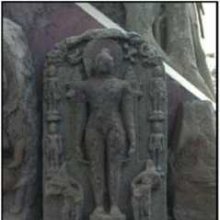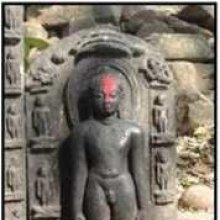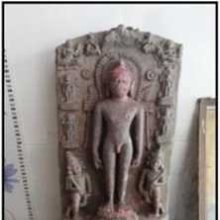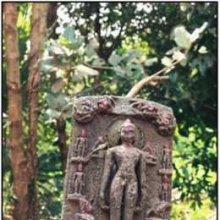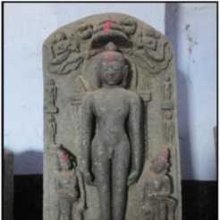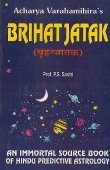Panca, Pancan, Pañca, Pañcan, Pamca, Pañcāṉ: 34 definitions
Introduction:
Panca means something in Buddhism, Pali, Hinduism, Sanskrit, Jainism, Prakrit, the history of ancient India, Marathi, Hindi, Tamil. If you want to know the exact meaning, history, etymology or English translation of this term then check out the descriptions on this page. Add your comment or reference to a book if you want to contribute to this summary article.
Alternative spellings of this word include Pancha.
Images (photo gallery)
(+29 more images available)
In Hinduism
Kavya (poetry)
Source: Wisdom Library: KathāsaritsāgaraPañca (पञ्च) is the name of the fourteenth book of the Kathāsaritsāgara, written by Somadeva in the 11th-century.
The Kathāsaritsāgara (‘ocean of streams of story’), mentioning Pañca, is a famous Sanskrit epic story revolving around prince Naravāhanadatta and his quest to become the emperor of the vidyādharas (celestial beings). The work is said to have been an adaptation of Guṇāḍhya’s Bṛhatkathā consisting of 100,000 verses, which in turn is part of a larger work containing 700,000 verses.
Source: archive.org: Naisadhacarita of SriharsaPañca (पञ्च) refers to “wide”, and is mentioned in the Naiṣadha-carita 22.19.

Kavya (काव्य, kavya) refers to Sanskrit poetry, a popular ancient Indian tradition of literature. There have been many Sanskrit poets over the ages, hailing from ancient India and beyond. This topic includes mahakavya, or ‘epic poetry’ and natya, or ‘dramatic poetry’.
Ayurveda (science of life)
Nighantu (Synonyms and Characteristics of Drugs and technical terms)
Source: WorldCat: Rāj nighaṇṭuPañca (पञ्च) is another name for Paṭola, a medicinal plant identified with Trichosanthes dioica (pointed gourd) from the Cucurbitaceae or “gourd family” of flowering plants, according to verse 3.22-24 of the 13th-century Raj Nighantu or Rājanighaṇṭu. The third chapter (guḍūcyādi-varga) of this book contains climbers and creepers (vīrudh). Together with the names Pañca and Paṭola, there are a total of sixteen Sanskrit synonyms identified for this plant.

Āyurveda (आयुर्वेद, ayurveda) is a branch of Indian science dealing with medicine, herbalism, taxology, anatomy, surgery, alchemy and related topics. Traditional practice of Āyurveda in ancient India dates back to at least the first millenium BC. Literature is commonly written in Sanskrit using various poetic metres.
Purana and Itihasa (epic history)
Source: archive.org: Shiva Purana - English TranslationPañca (पञ्च) refers to “(the) five (arrows of Kāma)”, according to the Śivapurāṇa 2.3.17 (“The dialogue between Indra and Kāmadeva”).—Accordingly, as Kāma said to Brahmā: “[...] O dear friend, I shall cause the downfall of that enemy of yours who is performing a severe penance to usurp your position. [...] I can undoubtedly make Brahmā and Viṣṇu go astray. Others are of no consideration. I shall make even Śiva fall. I have only five arrows that are soft [i.e., pañca-bāṇa—paṃcaiva mṛdavo bāṇāste] and flowery. My bow is of three types. That too is flowery. The bowstring consists of bees. My support and strength is my beloved wife Ratī. Spring is my minister. O god, I am having five forces. The moon, the storehouse of nectar, is my friend. [...]”.

The Purana (पुराण, purāṇas) refers to Sanskrit literature preserving ancient India’s vast cultural history, including historical legends, religious ceremonies, various arts and sciences. The eighteen mahapuranas total over 400,000 shlokas (metrical couplets) and date to at least several centuries BCE.
Shaivism (Shaiva philosophy)
Source: Brill: Śaivism and the Tantric Traditions (philosophy)Pañca (पञ्च) [=Pañcaka?] refers to “five (elements)”, according to the Īśvarapratyabhijñāvivṛtivimarśinī 2.131:—“[...] For the former [i.e., Ṣaḍdhātusamīkṣā] acknowledge that ordinary human practice is accounted for if this much [is admitted]: the five elements (bhūta-pañcaka) and consciousness, because such other [things as] the sense organs are included in these; whereas the latter admit that the ordinary human practice [consisting in the relationship between] an apprehending [subject] and an apprehended [object] is accounted for if a particular transformation called ‘consciousness’ arises in the four elements from [some of their] various combinations, and if this transformation does not arise [from other combinations of the four elements]”.

Shaiva (शैव, śaiva) or Shaivism (śaivism) represents a tradition of Hinduism worshiping Shiva as the supreme being. Closely related to Shaktism, Shaiva literature includes a range of scriptures, including Tantras, while the root of this tradition may be traced back to the ancient Vedas.
Vaishnavism (Vaishava dharma)
Source: Brill: Śaivism and the Tantric Traditions (vaishnavism)Pañca (पञ्च) refers to the “five (weapons) (of Murāri)”, according to the Vedānta Deśika’s Yatirājasaptati.—When we come to the poem’s understanding of the divinity of Rāmānuja we find a wide spectrum of meanings. In verse 12, which agrees with verse 33 of the Irāmāṉuja Nūṟṟantāti, Rāmānuja is seen as the coming together of all the five weapons (pañca-āyudha) of Murāri [apṛthakpratipanna yanmayatvaiḥ vavṛdhe pañcabhir āyudhair murāreḥ, 12cd].

Vaishnava (वैष्णव, vaiṣṇava) or vaishnavism (vaiṣṇavism) represents a tradition of Hinduism worshipping Vishnu as the supreme Lord. Similar to the Shaktism and Shaivism traditions, Vaishnavism also developed as an individual movement, famous for its exposition of the dashavatara (‘ten avatars of Vishnu’).
In Buddhism
Theravada (major branch of Buddhism)
Source: Journey to Nibbana: Patthana DhamaPanca means five.
Source: Buddhist Information: A Survey of Paramattha DhammasIn Pali, panca means five.
Theravāda is a major branch of Buddhism having the the Pali canon (tipitaka) as their canonical literature, which includes the vinaya-pitaka (monastic rules), the sutta-pitaka (Buddhist sermons) and the abhidhamma-pitaka (philosophy and psychology).
Mahayana (major branch of Buddhism)
Source: academia.edu: A Study and Translation of the GaganagañjaparipṛcchāPañca (पञ्च) refers to “five” (i.e., ‘five kinds of sight’, ‘five kinds of abilities’, ‘five states of existence’ and ‘five aggregates’), according to the Gaganagañjaparipṛcchā: the eighth chapter of the Mahāsaṃnipāta (a collection of Mahāyāna Buddhist Sūtras).—Accordingly, “Then, the Lord went on to speak these verses: ‘[...] (82) The dharma is taught in order to purify the five kinds of sight (pañca-cakṣus), to illuminate the five kinds of abilities (pañca-indriya), to eliminate the five states of existence (pañca-gati), and to makes the five aggregates disappear (pañca-skandha). It is not dependent on this side nor that side, but established in the realm of the dharma, same as the sameness of the sky, and it exalts a being in accordance with the knowledge of the Buddha. [...]’”.

Mahayana (महायान, mahāyāna) is a major branch of Buddhism focusing on the path of a Bodhisattva (spiritual aspirants/ enlightened beings). Extant literature is vast and primarely composed in the Sanskrit language. There are many sūtras of which some of the earliest are the various Prajñāpāramitā sūtras.
In Jainism
General definition (in Jainism)
Source: The University of Sydney: A study of the Twelve Reflections1) Pañca (पञ्च) or Pañcadhāraṇā refers to “five (acts of concentration)”, according to the 11th century Jñānārṇava, a treatise on Jain Yoga in roughly 2200 Sanskrit verses composed by Śubhacandra.—Accordingly, “In abiding-in-objects [meditation], there are to be known five acts of concentration (pañca-dhāraṇā—pañca vijñeyā dhāraṇā) described by the heroes [of the past]. The one who is restrained who is expert in them cuts through the bonds of life”.
2) Pañca (पञ्च) or Pañcamahāvrata refers to the “five (great vows)” according to the Jñānārṇava.—Accordingly, “Good conduct is said by one who is honourable [to be like a tree] whose roots are the five great vows (pañca-mahāvrata-mūla), whose foliage is the [mendicant] rule of life which is faultless in a high degree, bent with the weight of the fruit of restraint [of body, mind and speech]”.
3) Pañca (पञ्च) (or Pañcadhātu, Pañcaprakāra) refers to the “five-fold (nature)” (of the cycle of rebirth), according to the Jñānārṇava.—Accordingly, “[com.—Next he speaks about the five-fold nature [of the cycle of rebirth] (pañcadhātvam) for living souls (jīvānāṃ)]—Sentient beings, inflamed by very intense pleasure [and] unsteady from affliction by wrong faith, wander about in a five-fold [com.—with a nature of five modes (pañcaprakāratvena)] life that is difficult to be traversed. It has been stated at length that the cycle of rebirth which is full of suffering is five-fold on account of combining substance, place, right time, life and intention”.
4) Pañca (पञ्च) or Pañcāṇuvratā refers to the “five (minor vows)”, according to the Yogaśāstra verse 2.1.—Accordingly, “As far as a householder is concerned, the roots of orthodoxy are the five minor vows (pañca-aṇuvratā), the three virtuous [vows] (guṇavrata), [and] the four educational vows (śikṣāvrata). [These twelve vows progressively bring him closer to the life of a mendicant]”.
5) Pañca (पञ्च) or Pañcaviṣaya refers to the “five (objects of the senses)”, according to the Jñānārṇava.—Accordingly, “These, that is, the passions beginning with anger, the five objects of the senses (pañca-viṣaya—pañca viṣayāḥ) which are the companions of lust, carelessness, wrong faith, speech and mind, and the body, the two [kinds of] bad meditation having a bad end and lack of restraint thus decidedly issue from the mass of evil of men inspiring fear of life. [Thus ends the reflection on] the influx of karma”.

Jainism is an Indian religion of Dharma whose doctrine revolves around harmlessness (ahimsa) towards every living being. The two major branches (Digambara and Svetambara) of Jainism stimulate self-control (or, shramana, ‘self-reliance’) and spiritual development through a path of peace for the soul to progess to the ultimate goal.
India history and geography
Source: Cologne Digital Sanskrit Dictionaries: Indian Epigraphical GlossaryPañca.—(EI 22, 23), abbreviation of pañcakula; same as Mahājana; a Pañcāyat Board. Note: pañca is defined in the “Indian epigraphical glossary” as it can be found on ancient inscriptions commonly written in Sanskrit, Prakrit or Dravidian languages.

The history of India traces the identification of countries, villages, towns and other regions of India, as well as mythology, zoology, royal dynasties, rulers, tribes, local festivities and traditions and regional languages. Ancient India enjoyed religious freedom and encourages the path of Dharma, a concept common to Buddhism, Hinduism, and Jainism.
Languages of India and abroad
Pali-English dictionary
Source: BuddhaSasana: Concise Pali-English Dictionarypañca : (adj.) five.
Source: Sutta: The Pali Text Society's Pali-English DictionaryPañca, (adj. -num.) (Ved. pañca, Idg. *penqǔe; cp. Gr. pέnte, Lat. quīnque, Goth. fimf, Lith. penki, Oir. coic) number 5.—Cases: Gen. Dat. pañcannaṃ, Instr. Abl. pañcahi, Loc. pañcasu; often used in compositional form pañca° (cp. Ved. pañcāra with 5 spokes I. 16413; Gr. pempw/bolos, Lat. quinqu-ennis etc.).—
1. Characteristics of No. 5 in its use, with ref, to lit. & fig. application. “Five” is the number of “comprehensive and yet simple” unity or a set; it is applied in all cases of a natural and handy comprehension of several items into a group, after the 5 fingers of the hand, which latter lies at the bottom of all primitive expressions of No. 5 (see also below pañc’ aṅgulika. The word for 5 itself in its original form is identical with the word for hand *pr∂q, cp. Lat. com°, decem, centum etc.) -
A. No. 5, applied (a) with ref. to time: catupañcāhaṃ 4 or 5 days J. II, 114 (cp. quinque diebus Horace Sat I. 316); maraṇaṃ tuyhaṃ oraṃ māsehi pañcahi after 5 months Vv 6310, p. māse vasitvā DA. I, 319 (cp. qu. menses Hor. Sat. II. 3289).—(b) of space: °yojanaṭṭhāna J. III, 504; °yojan-ubbedho gajavaro VvA. 33; °bhūmako pāsādo J. I, 58 (cp. the house of Death as 5 stories high in Grimm, Mārchen No. 42 ed. Reclam).—(c) of a group, set, company, etc. (cp. 5 peoples RV III, 379; VI, 114; VIII, 92 etc.; gods X. 553; priests II. 3414; III, 77; leaders of the Greek ships Hom. Iliad 16, 171; ambassadors Genesis 472; quinque viri Hor. Sat. II. 555; Epist. II. 124): p. janā J. V, 230; p. amaccā J. V, 231; p. hatthino DhA. I, 164; pañca nāriyo agamiṃsu Vv 322; p. puttāni khādāmi Pv. I, 63.—Note. No. 5 in this appln is not so frequent in Pāli as in older literature (Vedas e.g. ); instead of the simple 5 we find more frequent the higher decimals 50 and 500. See also below §§ 3, 4.
B. No. 15 in two forms: pañcadasa (f. °ī the 15th day of the month Vv 156=A. I, 144; Sn. 402) VvA. 67 (°kahāpaṇa-sahassāni dāpesi), and paṇṇarasa (also as f. ī of the 15th or full-moon day Pv III, 31; DhA. I, 198; III, 92; IV, 202; VvA. 314; SnA 78) Sn. 153 (pannaraso uposatho); Vv 642 (paṇṇarase va cando; explained as paṇṇarasiyaṃ VvA. 276); DhA. I, 388 (of age, 15 or 16 years); DA. I, 17 (°bhedo Khuddaka-nikāyo); SnA 357 (pannarasahi bhikkhu-satehi=1500, instead of the usual 500); PvA. 154 (°yojana). The appln is much the same as 5 and 50 (see below), although more rare, e.g. as measure of space: °yojana DhA. I, 17 (next in sequence to paṇṇāsa-yojana); J. I, 315; PvA. 154 (cp. 15 furlongs from Jerusalem to Bethany John 11, 18; 15 cubits above the mountains rose the flood Gen. 7. 20).
C. No. 25 in two forms: pañcavīsati (the usual) e.g. DhsA. 185 sq.; Miln. 289 (citta-dubbalī-karaṇā dhammā); paṇṇa-vīsati, e.g. J. IV, 352 (nāriyo); Th. 2, 67, and paṇṇuvīsaṃ (only at J. III, 138). Similarly to 15 and 25 the number 45 (pañca-cattāḷīsa) is favoured in giving distances with °yojana, e.g. at J. I, 147, 348; DhA. I, 367. -Application: of 25: (1) time: years J. III, 138; DhA. I, 4; (2) space: miles high and wide DhA. II, 64 (ahipeto); VvA. 236 (yojanāni pharitvā pabhā).
2. Remarks on the use of 50 and 500 (5000). Both 50 and 500 are found in stereotyped and always recurring combinations (not in Buddhist literature alone, but all over the Ancient World), and applied to any situation indiscriminately. They have thus lost their original numerical significance and their value equals an expression like our “thousands, ” cp. the use of Lat. mille and 600, also similarly many other high numerals in Pāli literature, as mentioned under respective units (4, 6, 8 e.g. in 14, 16, 18, etc.). Psychologically 500 is to be explained as “a great hand, ” i.e. the 5 fingers magnified to the 2nd decade, and is equivalent to an expression like “a lot” (originally “only one, ” cp. casting the lot, then the one as a mass or collection), or like heaps, tons, a great many, etc.—Thus 50 (and 500) as the numbers of “comm-union” are especially frequent in recording a company of men, a host of servants, animals in a herd, etc., wherever the single constituents form a larger (mostly impressive, important) whole, as an army, the king’s retinue, etc.—A. No. 50 (paññāsa; the by-form paṇṇāsa only at DhA. III, 207), in foll. applns: (a) of time: does not occur, but see below under 55.—(b) of space (cp. 50 cubits the breadth of Noah’s ark Gen. 6. 15; the height of the gallows (Esther 5. 14; 7. 9) J. I, 359 (yojanāni); DhA. III, 207 (°hattho ubbedhena rukkho); Vism. 417 (paripuṇṇa °yojana suriyamaṇḍala); DhA. I, 17 (°yojana).—(c) of a company or group (cp. 50 horses RV II. 185; V, 185; wives VIII, 1936; men at the oars Hom. Il. 2. 719; 16. 170, servants Hom. Od. 7, 103, 22, 421) J. III, 220 (corā); V, 161 (pallaṅkā), 421 (dijakaññāyo); Sn. p. 87; SnA 57 (bhikkhū).—Note. 55 (pañcapaññāsa) is used instead of 50 in time expressions (years), e.g. at DhA. I, 125; II, 57; PvA. 99, 142; also in groups: DhA. I, 99 (janā).—B. No. 500 (pañcasata°, pañcasatā, pañcasatāni).—(a) of time: years (as Peta or Petī) Vv 8434; Pv. II, 15; PvA. 152 (with additional 50). (b) of space: miles high Pv IV. 328; J. I, 204 (°yojana-satikā); Vism. 72 (°dhanu-satika, 500 bows in distance).—(C) of groups of men, servants, or a herd, etc. (cp. 500 horses RV X. 9314; witnesses of the rising of Christ 1 Cor. 15—6; men armed Vergil Aen. 10. 204; men as representatives Hom. Od. 3. 7; 500 knights or warriors very frequently in Nibelungenlied, where it is only meant to denote a “goodly company, 500 or more”) Arahants KhA 98; Bhikkhus very frequent, e.g. D. I, 1; Vin. II, 199; J. I, 116, 227; DhA. II, 109, 153; III, 262, 295; IV, 184, 186; Sāvakas J. I, 95; Upāsakas J. II, 95; PvA. 151; Paccekabuddhas DhA. IV, 201; PvA. 76; Vighāsâdā J. II, 95; DhA. II, 154; Sons PvA. 75; Thieves DhA. II, 204; PvA. 54; Relatives PvA. 179; Women-servants (parivārikā itthiyo) Pv. II, 126; VvA. 69, 78, 187; PvA. 152; Oxen A. IV, 41; Monkeys J. III, 355; Horses Vin. III, 6.—Money etc. as present, reward or fine representing a “round-sum” (cp. Nibelungen 314: horses with gold, 317: mark; dollars as reward Grimm No. 7; drachms as pay Hor. Sat. II. 743) kahāpaṇas Sn. 980, 982; PvA. 273; blows with stick as fine Vin. I, 247.—Various: a caravan usually consists of 500 loaded wagons, e.g. J. I, 101; DhA. II, 79; PvA. 100, 112; chariots VvA. 78; ploughs Sn. p. 13. Cp. S. I, 148 (vyagghī-nisā); Vin. II, 285 (ūna-pañcasatāni); J. II, 93 (accharā); V, 75 (vāṇijā); DhA. I, 89 (suvaṇṇasivikā), 352 (rāja-satāni); IV, 182 (jāti°) KhA 176 (paritta-dīpā). Also BSk. pañ’opasthāyikā-śatāni Divy 529; pañca-mātrāṇi strī-śatāni Divy 533.—Note. When Gotama said that his “religion” would last 500 years he meant that it would last a very long time, practically for ever. The later change of 500 to 5, 000 is immaterial to the meaning of the expression, it only indicates a later period (cp. 5, 000 in Nibelungeniled for 500, also 5, 000 men in ambush Joshua 8. 12; converted by Peter Acts 4. 4; fed by Christ with 5 loaves Matthew 14. 21). Still more impressive than 500 is the expression 5 Koṭis (5 times 100, 000 or 10 million), which belongs to a comparatively later period, e.g. at DhA. I, 62 (ariya-sāvaka-koṭiyo), 256 (°mattā-ariyasāvakā); IV, 190 (p. koti-mattā ariya-sāvakā).
3. Typical sets of 5 in the Pali Canon. °aggaṃ first fruits of 5 (kinds), viz. khett°, rās°, koṭṭh°, kumbhi°, bhojan° i.e. of the standing crop, the threshing floor, the granary, the pottery, the larder SnA 270. °aṅgā 5 gentlemanly qualities (of king or brahmin): sujāta, ajjhāyaka, abhirūpa, sīlavā, paṇḍita (see aṅga; on another combination with aṅga see below). The phrase pañc’ aṅgasamannāgata & °vippahīna (S. I, 99; A. V, 16) refers to the 5 nīvaraṇāni: see explained at Vism. 146. °aṅgikaturiya 5 kinds of music: ātata, vitata, ātata-vitata, ghana, susira. °abhiññā 5 psychic powers (see Cpd. 209). °ānantarika-kammāni 5 acts that have immediate retribution (Miln. 25), either 5 of the 6 abhiṭhānas (q. v.) or (usually) murder, theft, impurity, lying, intemperance (the 5 sīlas) cp. Dhs. trsl. 267. °indriyāni 5 faculties, viz. saddhā, viriya, sati, samādhi, paññā (see indriya B. 15—19). °vidhaṃ (rāja-) kakudhabhaṇḍaṃ, insignia regis viz. vāḷavījanī, uṇhīsa, khagga, chatta, pādukā. °kalyāṇāni, beauty-marks: kesa°, maṃsa°, aṭṭhi°, chavi°, vaya°. °kāmaguṇā pleasures of the 5 senses (=taggocarāni pañc’āyatanāni gahitāni honti SnA 211). °gorasā 5 products of the cow: khīra, dadhi, takka, navanīta, sappi. °cakkhūni, sorts of vision (of a Buddha): maṃsa° dibba° paññā° buddha° samanta°. °taṇhā cravings, specified in 4 sets of 5 each: see Nd2 271v. °nikāyā 5 collections (of Suttantas) in the Buddh. Canon, viz. Dīgha° Majjhima° Saṃyutta°, Aṅguttara° Khuddaka°, e.g. Vin. II, 287. °nīvaraṇāni or obstacles: kāmacchanda, abhijjhā-vyāpāda, thīnamiddha, uddhacca-kukkucca, vicikicchā. °patiṭṭhitaṃ 5 fold prostration or veneration, viz. with forehead, waist, elbows, knees, feet (Childers) in phrase °ena vandati (sometimes °ṃ vandati, e.g. SnA 78, 267) J. V, 502; SnA 267, 271, 293, 328, 436; VvA. 6; DhA. I, 197; IV, 178, etc. °bandhana either 5 ways of binding or pinioning or 5 fold bondage J. IV, 3 (as “ure pañcaṅgika-bandhanaṃ” cp. kaṇṭhe pañcamehi bandhanehi bandhitvā S. IV, 201); Nda 304III, B2 (rājā bandhāpeti andhu-bandhanena vā rajju°, saṅkhalika°, latā°, parikkhepa°), with which cp. Śikṣāsamucc. 165: rājñā pañcapāśakena bandhanena baddhaḥ.—There is a diff. kind of bandhana which has nothing to do with binding, but which is the 5 fold ordeal (obligation: pañcavidhabandhana-kāraṇaṃ) in Niraya, and consists of the piercing of a red hot iron stake through both hands, both feet and the chest; it is a sort of crucifixion. We may conjecture that this “bandhana” is a corruption of “vaddhana” (of vyadh, or viddhana?), and that the expression originally was pañcaviddhana-kāraṇa (instead of pañca-vidha-bandhana-k°). See passages under bandhana & cp. M. III, 182; A. I, 141; Kvu 597; SnA 479. °balāni 5 forces: saddhā° viriya° sati° samādhi° paññā° D. II, 120; M. II, 12; S. III, 96; A. III, 12 (see also bala). °bhojanāni 5 kinds of food: odāna, kummāsa, sattu, maccha, maṃsa Vin. IV, 176. °macchariyāni 5 kinds of selfishness: āvāsa° kula° lābha° vaṇṇa° dhamma°. °rajāni defilements: rūpa°, sadda° etc. (of the 5 senses) Nd1 505; SnA 574. °vaṇṇā 5 colours (see ref. for colours under pīta and others), viz. nīla, pītaka, lohitaka, kaṇha, odāta (of B’s eye) Nd2 235Q; others with ref. to paduma-puṇḍarīka VvA. 41; to paduma DhA. III, 443; to kusumāni DA. I, 140; DhA. IV, 203. °vaṇṇa in another meaning (fivefold) in connection with pīti (q. v.). °saṃyojanāni fetters (q. v.). °saṅgā impurities, viz. rāga, dosa, moha, māna, diṭṭhi (cp. taṇhā) DhA. IV, 109. °sīla the 5 moral precepts, as sub-division of the 10 (see dasasīla and Nd2 under sīla on p. 277).
4. Other (not detailed) passages with 5: Sn. 660 (abbudāni), 677 (nahutāni koṭiyo pañca); Th. 2, 503 (°kaṭuka=pañcakāmaguṇa-rasa ThA. 291); DhA. II, 25 (°mahānidhi); SnA 39 (°pakāra-gomaṇḍala-puṇṇabhāva). Cp. further: guṇā Miln. 249; paṇṇāni Vin. I, 201 (nimba°, kuṭaja°, paṭola°, sulasi°, kappāsika°); Paṇḍu-rāja-puttā J. V, 426; pabbagaṇṭhiyo Miln. 103; pucchā DhsA. 55; mahā-pariccāgā DhA. III, 441; mahā-vilokanāni DhA. I, 84; vatthūni Vin. II, 196 sq.; vāhanāni (of King Pajjota) DhA. I, 196; suddhāvāsā Dhs. A 14. In general see Vin. V, 128—133 (var. sets of 5).
Pañca, compounds:

Pali is the language of the Tipiṭaka, which is the sacred canon of Theravāda Buddhism and contains much of the Buddha’s speech. Closeley related to Sanskrit, both languages are used interchangeably between religions.
Marathi-English dictionary
Source: DDSA: The Molesworth Marathi and English Dictionarypañca (पंच).—a (S) Five.
--- OR ---
pañca (पंच).—m (S The ca is ts.) A member of an assembly of arbitration. Used pl it signifies the assembly, as this usually consists of five members. 2 A jury.
--- OR ---
pañcā (पंचा).—m (Tsha.) An article of dress,--a piece about one cubit in breadth and six in length, worn like the dhōtara around the middle of the body. v nēsa. 2 R (Properly pañjā) The hand as expanded or opened out: also a claw.
--- OR ---
pāñca (पांच).—a (pañca S) Five. 2 Used like the word cāra for a moderate quantity or number. Ex. tyāpāsīṃ pāñca rupayē āhēta; pāñca karatīla tēṃ āpaṇa karāvēṃ; Pr. mājhēṃ ghyā āṇi pāñcānta nyā. pāñca tēthēṃ paramēśvara Vox populi vox Dei. pāñcācī pāñca buddhi or pāñcācē pāñca prakāra Quot homines tot sententiæ: also suus cuique mos. pāñcāntūna uṭhaṇēṃ To become outcast or isolated from society. pāñcāvara dhāraṇa basaṇēṃ To be frightened to death (i. e. out of one's five vital airs).
Source: DDSA: The Aryabhusan school dictionary, Marathi-Englishpañca (पंच).—a Five.
--- OR ---
pañca (पंच).—m A member of an assembly of ar- bitration. pl It signifies the assem- bly, as this usually consists of five members. A jury.
--- OR ---
pañcā (पंचा).—m An article of dress, a small dhotar.
--- OR ---
pāñca (पांच).—a Five. Pr. mājhēṃ ghyā āṇi pāñcānta nyā. pāñca tēthēṃ paramēśvara Vox populi vox Dei. pāñcācī pāñca buddhi or pāñcāñcē pāñca prakāra Quot homines tot sententiæ: also suns cui- que mos. pāñcāntūna uṭhaṇēṃ To become out- caste or isolated from society. pāñcāṃvara dhāraṇa basaṇēṃ To be frightened to death (i. e. out of one's five vital airs).
Marathi is an Indo-European language having over 70 million native speakers people in (predominantly) Maharashtra India. Marathi, like many other Indo-Aryan languages, evolved from early forms of Prakrit, which itself is a subset of Sanskrit, one of the most ancient languages of the world.
Sanskrit dictionary
Source: DDSA: The practical Sanskrit-English dictionaryPañca (पञ्च).—a. Spread, extended.
Source: DDSA: The practical Sanskrit-English dictionaryPañcan (पञ्चन्).—num. a. (Always pl., nom. and acc. pañca) Five. (As the first member of comp. pañcan drops its final n). [cf. Gr. pente.]
Source: Cologne Digital Sanskrit Dictionaries: Shabda-Sagara Sanskrit-English Dictionary
Pañcan (पञ्चन्).—mfn. plu. (-ñca) Five. E. paci to spead, Unadi aff. kanin .
Source: Cologne Digital Sanskrit Dictionaries: Benfey Sanskrit-English DictionaryPañca (पञ्च).—[-pañca] (see pañcan); in catuḥpañca, i. e. catur-, adj. Four or five, [Rājataraṅgiṇī] 6, 326.
--- OR ---
Pañcā (पञ्चा).—[pañc + ā], f. Spreading; in cañcatpañca, i. e. cañcant-, adj. Shaking in all its parts, [Uttara Rāmacarita, 2. ed. Calc., 1862.] 120, 3 (v. r.).
Source: Cologne Digital Sanskrit Dictionaries: Benfey Sanskrit-English DictionaryPañcan (पञ्चन्).—numer. adj. Five, [Mānavadharmaśāstra] 2, 43.
Source: Cologne Digital Sanskrit Dictionaries: Cappeller Sanskrit-English DictionaryPañcan (पञ्चन्).—[adjective] five.
--- OR ---
Pañcan (पञ्चन्).—[adjective] five.
Source: Cologne Digital Sanskrit Dictionaries: Monier-Williams Sanskrit-English Dictionary1) Pañca (पञ्च):—[from pañc] 1a mf(ā)n. spread out, [Uttararāma-carita]
2) [v.s. ...] m. (in music) a kind of measure.
3) [from pañc] 1b See under 1. pac, [ib.]
4) 2 in [compound] for pañcan (See p.578).
5) Pāñca (पाञ्च):—Vṛddhi form of pañca ([from] pañcan), in [compound]
Source: Cologne Digital Sanskrit Dictionaries: Monier-Williams Sanskrit-English Dictionary1) Pañcan (पञ्चन्):—[from pañca] [plural] (said to be [from] √1. pac, to spread out the hand with its five fingers; [nominative case] [accusative] pañca [Atharva-veda v, 15, 5] pañca; [instrumental case] cabhis; [dative case] [ablative] cabhyas; [locative case] casu [Class. also, cabhis, cabhyas, casu cf. [Pāṇini 6-1, 179 etc.]]; [genitive case] cānām) five, [Ṛg-veda] etc. etc. (cf. under indriya, kṛṣṭi, carṣaṇi, jana, bhūta, mātra, yajña, svasṛ etc.); sg. Name of [Kathāsaritsāgara xiv.]
2) [v.s. ...] cf. [Zend] pañcan; [Greek] πέντε, [Aeolic] πέμπε; [Latin] quinque; [Lithuanian] penkí; [Gothic] fimf; [German] fönf; [Anglo-Saxon] fif; [English] five.
Source: Cologne Digital Sanskrit Dictionaries: Yates Sanskrit-English DictionaryPañcan (पञ्चन्):—(ñca) a. Five.
Source: DDSA: Paia-sadda-mahannavo; a comprehensive Prakrit Hindi dictionary (S)Pañcan (पञ्चन्) in the Sanskrit language is related to the Prakrit word: Paṃca.
[Sanskrit to German]
Sanskrit, also spelled संस्कृतम् (saṃskṛtam), is an ancient language of India commonly seen as the grandmother of the Indo-European language family (even English!). Closely allied with Prakrit and Pali, Sanskrit is more exhaustive in both grammar and terms and has the most extensive collection of literature in the world, greatly surpassing its sister-languages Greek and Latin.
Hindi dictionary
Source: DDSA: A practical Hindi-English dictionary1) Paṃca (पंच) [Also spelled panch]:——an allomorph of [paṃca] (five) used in a number of compound words; ~[mela] a mixture of five; a mixture of five kinds of sweetmeat; ~[raṃgā] five-coloured; ~[laḍā] consisting of five strings; ~[harā] quintuplicate.
2) Paṃca (पंच) [Also spelled panch]:—(a) five; (nm) the number five; an arbitrator or a body of arbiters or jury; the headman of a caste or village; ~[ka] a set or aggregate of five; in Astrology, a coincidence of five stars wherein commencement of an auspicious ceremony is prohibited; ~[karma] the five actions of the body as propounded under the Indian medicinal system; ~[koṇa] a pentagon; ~[kośa] according to the Vedant, the five covering shells of the soul viz. [annamaya kośa, prāṇamaya kośa, manomaya kośa, vijñānamaya kośa] and [ānaṃdamaya kośa; ~khanā] five-storeyed; ~[gavya] the five products of the cow, viz. milk, curd (coagulated milk), butter and the liquid and solid excreta ([gobara] and [gomūtra]); ~[guṇa] five-times; the five attributes of sound ([śabda]), touch ([sparśa]), form ([rūpa]), taste ([rasa]) and smell ([gaṃdha]); ~[tattva] the five essential elements viz, earth, water, fire, air and ether; ~[tva] the transformation of the five elements of the body ([paṃcabhūta]) to their respective original forms; death; •[ko prāpta honā] lit. to be transformed into the five original elements—to expire; ~[daśa] fifteen; ~[deva] the five major gods of the Hindus—Vishnu,Shiv, Ganēsh, Sury, Darga:; ~[nada] having five rivers; the province of Punjab in pre-partition India; ~[nāmā] the mutualy written agreement between the contending parties; to appoint an arbitrator or a body of arbitrators; ~[pātra] the five vessels of adoration collectively; a vessel used for offering water to the idol; ~[prāṇa] the five vital airs of the body; -[phaisalā] arbitration, the award of a court of arbitration; ~[bhūta] the five elements viz. earth, fire, water, air and ether; ~[bhūtātmā] a human being made up of the [paṃcabhūta; ~makāra] in religious rites of the Vam-ma: rgis, the five essentials each beginning with the letter [`ma'] viz. [madya] (wine), [māṃsa] (human flesh), [matsya] (fish), [mudrā] (gesticulation) and [maithuna] (copulation); —[mahāyajña] the five great sacrifices specified for the Hindus viz. the worship of the spirits ([bhūtayajña]); the worship of progenitors ([pitṛyajña]); the worship of gods ([devayajña]); the worship of the Vedas ([brahmayajña]), and the worship of mankind ([nṛyajña); ~lauha] an alloy of five metals, viz. gold, silver, copper, tin and lead; ~[vaṭī] the aggregate of the five trees ([pīpala, bela, baḍa, haḍa] and [aśoka]); the venue of Ram's stay in Dandakaranny while in banishment; ~[varṣīya] quinquennial; ~[śīla] the five basic principles of international conduct designed to achieve and consolidate world peace, first enunciated by Free India's first Prime Minister, Pandit Jawaharlal Nehru:—(1) respect for each other’s sovereignty and territorial integrity; (2) assurance of mutual non-aggression; (3) non-interference in each other’s internal affairs; (4) equality and co-operation for mutual benefit; (5) peaceful co-existence; —[kī duhāī] appeal to the arbitrators (for help); —[parameśvara] taking the arbitrator as representing God; —[badanā/mānanā] to agree on an arbitrator/mediator.
3) Pāṃca (पांच):—(a) five; (nm) the number five; [pāṃcoṃ] ([uṃgaliyāṃ]) [ghī meṃ honā] to live on the fat of the land, to have one’s bread buttered on both sides; to attain the utmost/highest advantage, to thrive on all fronts; [pāṃcoṃ uṃgaliyāṃ barābara nahīṃ hotīṃ] all are not equal, all of a clan are not alike; [pāṃcoṃ savāroṃ meṃ nāma likhānā] to count/consider oneself amongst the privileged few.
...
Prakrit-English dictionary
Source: DDSA: Paia-sadda-mahannavo; a comprehensive Prakrit Hindi dictionaryPaṃca (पंच) in the Prakrit language is related to the Sanskrit word: Pañcan.
Prakrit is an ancient language closely associated with both Pali and Sanskrit. Jain literature is often composed in this language or sub-dialects, such as the Agamas and their commentaries which are written in Ardhamagadhi and Maharashtri Prakrit. The earliest extant texts can be dated to as early as the 4th century BCE although core portions might be older.
Kannada-English dictionary
Source: Alar: Kannada-English corpusPaṃca (ಪಂಚ):—[noun] a thing that is not frequently encountered or is scarce; a rare thing.
--- OR ---
Paṃca (ಪಂಚ):—[adjective] amounting to five in number; five.
--- OR ---
Paṃca (ಪಂಚ):—
1) [noun] the cardinal number five.
2) [noun] a member of the group of people who hear the evidence and inquire into the facts in a litigation in a village or town; a jury.
3) [noun] a member of a commission authorised to perform certain duties or tasks.
--- OR ---
Paṃca (ಪಂಚ):—[adjective] extending over a larger area from side to side than is usual or normal; wide; broad.
Kannada is a Dravidian language (as opposed to the Indo-European language family) mainly spoken in the southwestern region of India.
Nepali dictionary
Source: unoes: Nepali-English Dictionary1) Pañca (पञ्च):—n. 1. five; 2. jury; a committee of five gentlemen; 3. dated. a member of (village) Panchayat;
2) Panca (पन्च):—n. punching machine;
3) Pāṃca (पांच):—[=पाँच] n./adj. num. five; 5;
Nepali is the primary language of the Nepalese people counting almost 20 million native speakers. The country of Nepal is situated in the Himalaya mountain range to the north of India.
See also (Relevant definitions)
Starts with (+1530): Five Hindrances, Pamcababu, Pamcabali, Pamcabhaksha, Pamcabhakshya, Pamcabhisheka, Pamcabhujakriti, Pamcabhuji, Pamcadara, Pamcadashitopu, Pamcadhare, Pamcaga, Pamcagajjaya, Pamcagalu, Pamcagarti, Pamcagatte, Pamcagaula, Pamcaghamte, Pamcagulma, Pamcagumdige.
Ends with (+34): Adapanca, Akarapanca, Antaraprapanca, Aprapanca, Atipanca, Atipapanca, Aviprapanca, Bahiprapanca, Bahuprapanca, Bahyaprapamca, Bhagapanca, Bhagyapanca, Bhartriprapanca, Catuhpanca, Catushpanca, Chapanca, Chappanca, Citraprapanca, Dushprapanca, Dvipanca.
Full-text (+1756): Pancabhautika, Pancashara, Pancanakha, Panci, Pancangula, Pancavata, Pancayajnika, Pancavaktra, Pancagavya, Pancakritvas, Pancavalkala, Pancaratrika, Sarpanch, Pancasugandhaka, Adapanca, Pancashat, Pancagata, Pancataksha, Pancakona, Pancavrit.
Relevant text
Search found 206 books and stories containing Panca, Pancan, Pañca, Pañcan, Pamca, Pañcāṉ, Pañcā, Pāñca, Pamcan, Paṃcan, Paṃca, Pāṃca, Pancha, Panch, Panja, Panchaa, Panchan, Panchaan, Panchn, Panjan; (plurals include: Pancas, Pancans, Pañcas, Pañcans, Pamcas, Pañcāṉs, Pañcās, Pāñcas, Pamcans, Paṃcans, Paṃcas, Pāṃcas, Panchas, Panches, Panjas, Panchaas, Panchans, Panchaans, Panchns, Panjans). You can also click to the full overview containing English textual excerpts. Below are direct links for the most relevant articles:
Tattvartha Sutra (with commentary) (by Vijay K. Jain)
Verse 7.3 - The five observances (bhāvanā) < [Chapter 7 - The Five Vows]
Verse 7.24 - The transgressions for the vows and the supplementary vows < [Chapter 7 - The Five Vows]
Verse 7.7 - The observances for the vow of chastity (brahmacarya) < [Chapter 7 - The Five Vows]
Rig Veda (translation and commentary) (by H. H. Wilson)
A Manual of Khshnoom (by Phiroz Nasarvanji Tavaria)
Supplement No. 21 < [Supplements]
Trishashti Shalaka Purusha Caritra (by Helen M. Johnson)
Notes on Śīlāṅga (laws of good conduct) < [Notes]
Part 6: Previous births of Śāntimatī and Ajitasena < [Chapter III - Eighth incarnation as Vajrāyudha]
Yajnavalkya-smriti (Vyavaharadhyaya)—Critical study (by Kalita Nabanita)
Chapter 3.2 - Caste System (Introduction) < [Chapter 3 - The Social Aspect Depicted in the Vyavahārādhyāya]
Chapter 5.11 - Laws Relating to Rescission of Purchase (krītānuśaya) < [Chapter 5 - Vyavahārādhyāya and the Modern Indian Laws]
Chapter 3.7 - Economic Aspects of ancient India < [Chapter 3 - The Social Aspect Depicted in the Vyavahārādhyāya]
Chaitanya Bhagavata (by Bhumipati Dāsa)
Verse 1.8.182 < [Chapter 8 - The Disappearance of Jagannātha Miśra]
Verse 2.13.380 < [Chapter 13 - The Deliverance of Jagāi and Mādhāi]
Verse 1.12.242 < [Chapter 12 - The Lord’s Wandering Throughout Navadvīpa]
Related products
(+4 more products available)

